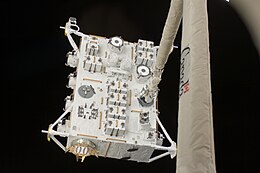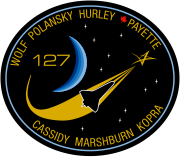 Canadarm2 grapples the exposed facility of Kibō, prior to its installation on the ISS | |
| Names | Space Transportation System-127 |
|---|---|
| Mission type | ISS assembly |
| Operator | NASA |
| COSPAR ID | 2009-038A |
| SATCAT no. | 35633 |
| Mission duration | 15 days, 16 hours, 44 minutes, 58 seconds |
| Distance travelled | 10,537,748 kilometres (6,547,853 mi) |
| Orbits completed | 248[1] |
| Spacecraft properties | |
| Spacecraft | Space Shuttle Endeavour |
| Crew | |
| Crew size | 7 |
| Members | |
| Launching | |
| Landing | |
| Start of mission | |
| Launch date | July 15, 2009, 22:03 UTC |
| Launch site | Kennedy, LC-39A |
| End of mission | |
| Landing date | July 31, 2009, 14:48 UTC |
| Landing site | Kennedy, SLF Runway 15 |
| Orbital parameters | |
| Reference system | Geocentric |
| Regime | Low Earth |
| Perigee altitude | 344 kilometres (214 mi)[2] |
| Apogee altitude | 351 kilometres (218 mi)[2] |
| Inclination | 51.6 degrees[1][2] |
| Period | 91.48 minutes[2] |
| Epoch | July 18, 2009[2] |
| Docking with ISS | |
| Docking port | PMA-2 (Harmony forward) |
| Docking date | July 17, 2009 17:47 UTC |
| Undocking date | July 28, 2009 17:26 UTC |
| Time docked | 10 days, 23 hours, 41 minutes |

 From left to right: Wolf, Cassidy, Hurley, Payette, Polansky, Marshburn, and Kopra | |
STS-127 (ISS assembly flight 2J/A) was a NASA Space Shuttle mission to the International Space Station (ISS).[1] It was the twenty-third flight of Space Shuttle Endeavour. The primary purpose of the STS-127 mission was to deliver and install the final two components of the Japanese Experiment Module: the Exposed Facility (JEM EF), and the Exposed Section of the Experiment Logistics Module (ELM-ES).[3][NASA 1] When Endeavour docked with the ISS on this mission in July 2009, it set a record for the most humans in space at the same time in the same vehicle, the first time thirteen people have been at the station at the same time.[4] Together they represented all ISS program partners[5] and tied the general record of thirteen people in space with the first such occurrence of 1995.[6]
The first launch attempt, on June 13, 2009, was scrubbed due to a gaseous hydrogen leak observed during tanking.[7][8] The Ground Umbilical Carrier Plate (GUCP) on the external fuel tank experienced a potentially hazardous hydrogen gas leak similar to the fault that delayed the Space Shuttle Discovery mission STS-119 in March 2009. Since a launch date of June 18, 2009, would have conflicted with the launch of the Lunar Reconnaissance Orbiter (LRO)/Lunar Crater Observation and Sensing Satellite (LCROSS), NASA managers discussed the scheduling conflict with both the Lunar Reconnaissance Orbiter project and the Air Force Eastern Range, which provides tracking support for rockets launched from Florida.[9][10] A decision was made to allow the shuttle to attempt a second launch on June 17, 2009, allowing LRO to launch on June 18, 2009.[8]
The second launch attempt on June 17, 2009, was also scrubbed due to hydrogen leak issues seen from the Ground Umbilical Carrier Plate.[11] Due to conflicts with the launch of the LRO, and due to a beta angle constraint, the next available launch opportunity was scheduled for July 11, 2009.[NASA 2][12] A successful tanking test for leak checks was performed on July 1, 2009, with modified GUCP seals allowing launch preparations to proceed as scheduled.[13] Because of lightning strikes near the launch pad during the evening of July 10, 2009, NASA scrubbed the launch for the third time and rescheduled for July 12, 2009.[14] Due to a Return To Launch Site (RTLS) weather violation, NASA scrubbed the launch for the fourth time on the evening of July 12, 2009.
STS-127's fifth launch attempt, on July 13, 2009, was also scrubbed due to anvil clouds and lightning within 10 nautical miles (19 km) of the launch site, which violated launch safety rules. STS-127 finally launched successfully on its sixth launch attempt, on July 15, 2009, at 18:03 EDT. Pieces of foam were observed falling off of the External Tank during the ascent, the same occurrence that had led to the loss of Columbia in 2003. However, Endeavour received only minor scuffs to its heat shield, the damage not enough to cause concern over reentry.[15] The shuttle landed at Kennedy Space Center 16 days later at 10:48 EDT on July 31, 2009.
- ^ a b c Harwood, William (June 1, 2009). "STS-127 Mission Quick-Look 1". CBS News. Retrieved June 1, 2009.
- ^ a b c d e McDowell, Jonathan. "Satellite Catalog". Jonathan's Space Page. Retrieved May 28, 2013.
- ^ "STS-127 Spaceflight Notepad" (PDF). Boeing. June 6, 2009. Retrieved June 12, 2009.
- ^ Klotz, Irene (June 12, 2009). "NASA fuels space shuttle Endeavour for launch". Reuters. Retrieved June 12, 2009.
- ^ "Mission STS-127". Canadian Space Agency. August 13, 2008. Retrieved October 20, 2021.
- ^ Malik, Tariq (March 27, 2009). "Population in Space at Historic High: 13". Space.com. Retrieved October 20, 2021.
- ^ Cite error: The named reference
scrub1was invoked but never defined (see the help page). - ^ a b Harwood, William (June 15, 2009). "NASA sets Wednesday launch date for shuttle Endeavour". CBS News. SpaceflightNow.com. Retrieved June 16, 2009.
- ^ Harwood for CBS News, William (June 13, 2009). "Space shuttle Endeavour launch postponed by leak". SpaceflightNow.com. Retrieved June 14, 2009.
- ^ Kenneth Chang (June 13, 2009). "Leak Halts Shuttle Launching". New York Times. Retrieved June 13, 2009.
- ^ Bergin, Chris (June 17, 2009). "STS-127 suffers another GUCP leak after late tanking". NASAspaceflight.com. Retrieved August 7, 2009.
- ^ Harwood, William (June 12, 2009). "STS-127 Launch Windows". CBS News. Retrieved June 14, 2009.
- ^ "Shuttle Endeavour to lift off Saturday if weather co-operates". CBC News. July 10, 2009. Retrieved July 10, 2009.
- ^ "NASA delays space shuttle Endeavour launch 1 day". Houston Chronicle. 11 July 2009. Archived from the original on 21 July 2009. Retrieved 11 July 2009.
- ^ Cite error: The named reference
sts127heatshieldwas invoked but never defined (see the help page).
Cite error: There are <ref group=NASA> tags on this page, but the references will not show without a {{reflist|group=NASA}} template (see the help page).